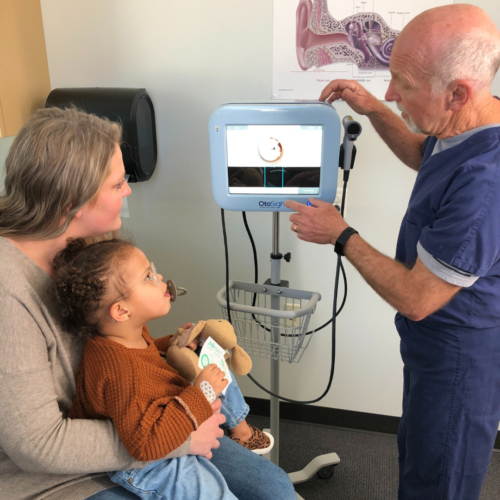Phone
866-411-EARS
Address
PhotoniCare Inc.
2800 Meridian Parkway, Suite 175
Durham, NC 27713

Itchiness or pain. Trouble hearing. Fluid leaking out of the ears. These symptoms may have been all too common when we were kids, but as an adult, the signs of an ear infection are probably something you have not felt in quite some time. While ear infections—middle ear infections in particular—are more common in children, they are not unheard of in adults. In this blog post we explore the risks and complications of leaving an ear infection untreated in adults.
In our last blog, we talked about the difference between middle ear infections (otitis media), and outer ear infections (otitis externa), more commonly known as swimmer’s ear. Otitis media is caused by either bacteria or viruses. A common cold, the flu, or allergy symptoms that cause congestion and swelling of the nasal passages, throat, and eustachian tubes can sometimes lead to an infection. Anything that makes the nose stuffy has a tendency to cause swelling and blockage of the eustachian tubes. Swelling from colds or allergies can keep the eustachian tubes from opening and this leads to pressure changes and the accumulation of fluid in the middle ear. This pressure and fluid will cause pain and sometimes persistent fluid can lead to an infection.
Swimmer’s ear, on the other hand, is an outer ear infection, typically caused by bacteria growing due to the presence of excess moisture in the ear or an abrasion to the lining of the ear canal. This type of infection is much more common in adults, whether they regularly hit the pool or not. The excess moisture that causes otitis externa can also come from baths and showers, or the infection can grow out of an aggressive cotton swab or even irritation from beauty products or jewelry.
Potential Complications
The Mayo Clinic notes that although the majority of ear infections do not cause lasting problems, recurring infections left untreated can lead to serious complications. Due to swelling and/or fluid buildup, ear infections often cause mild hearing loss, however it usually clears up along with the infection. Extensive fluid in the middle ear due to chronic ear infections, however, can lead to more severe damage to the eardrum, resulting in a more permanent hearing impairment.
Untreated chronic ear infections can also cause tears in the eardrum. These tears will typically heal within a few days, though in more extreme cases, surgical repair might be required.
The other primary risk of leaving an ear infection untreated is that the infection could spread beyond the ear. An untreated infection can spread to other nearby tissue in and around the ear, and in rare cases even into the skull, resulting in meningitis. Infections will more commonly spread to the mastoid, just behind the ear, which can damage the bone and form pus-filled cysts.
These complications highlight the critical need to monitor symptoms in the case of an ear infection and to seek treatment if they continue or even worsen after a day or two. While you may not need treatment right away, it is important to consult with your physician to know what to look out for and when to seek further testing in order to avoid more extensive damage. Initial diagnosis usually involves an examination, but lab testing may be needed if the infection does not clear up.
Ear Infection Treatments
The good news is, most ear infections clear up on their own, and when treatment is needed, it is usually relatively minor. Swimmer’s ear is typically treated with a thorough cleaning, ear drops, and over-the-counter pain medication as needed. A middle ear infection will more often than not be treated first by monitoring symptoms and possibly adding anesthetic drops if there are no signs of a tear in the eardrum. While antibiotics can also be used to treat middle ear infections, they are generally reserved for more extreme cases, so as not to build up unnecessary antibiotic resistance.
Ear Infection Prevention
The best ways to prevent ear infections involve the steps we take as adults to prevent the common cold and boost our immune systems. Wash your hands frequently, don’t sneeze or cough out into the air, and be careful when interacting with those who show symptoms of a virus (something we have become even more keenly aware of in the age of COVID-19). Avoid smoking and secondhand smoke and eat plenty of fruits and vegetables to keep your resistance up.
When it comes to an outer ear infection, make sure you dry your ears thoroughly after a bath, shower, or swim. Be extremely careful with cotton swabs and avoid strong movements that could scratch your ear canal.
And above all, pay attention to how you feel. If you notice out-of-the ordinary pain or itches, keep an eye on your symptoms and consult with your doctor so that you don’t risk letting a little ear infection get out of control. The risk of an infection may be low as an adult, but the consequences are not if left untreated.

The COVID-19 pandemic has created numerous challenges for parents. Navigating… Read More

PhotoniCare sits down with Dr. Michael Novak, an Ear, Nose… Read More

This week on the #EnginEarGuys blog we talk about otolaryngology… Read More